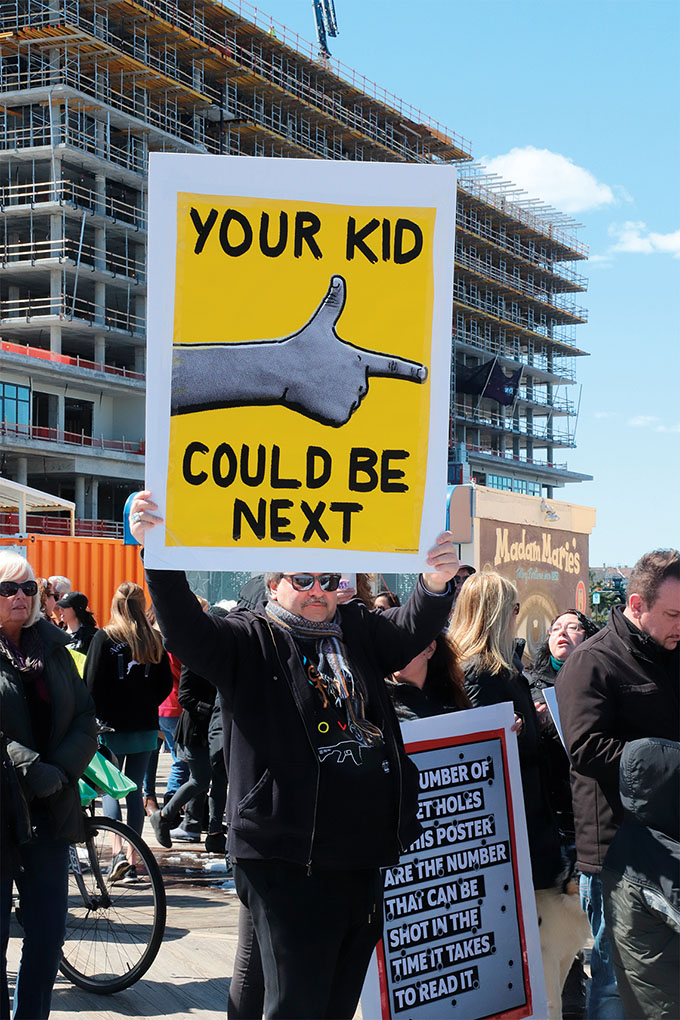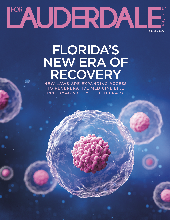
America’s ongoing national nightmare came to Broward County on Valentine’s Day, February 14, 2018.
Amid the post-Parkland media tsunami—the entirety of that nation-sized magnifying glass that hovered over our heartbreak for weeks and months and still today—one small thing was created that shows that day in devastating, blunt clarity. It was an animation created by the Marjory Stoneman Douglas High School Public Safety Commission. The animation was meant to demonstrate how, exactly, Nikolas Cruz worked his way through the school and shot 17 people to death, and it accomplishes that with a chilling simplicity. The animation takes an overhead perspective, showing a basic blueprint of the Stoneman Douglas hallways. Cruz is represented by a black dot with a line pointing from it. His classmates are green dots and the school staff are blue. When a dot goes yellow, it has been wounded. When a dot goes purple, it is dead. For the next seven minutes, the black dot slowly stalks the hallway and it happens.
Green, purple. Green, purple. It begins on the first floor of building 12. The black dot stops at each classroom. Green, purple. Green, purple. Green, purple. The black dot moves on to the third floor. Blue, purple. Green, purple. Green, purple. And more, and more.
The animation was released three months after the shooting and that might be what makes it so haunting. Because by then, they weren’t dots. By then we had met Emma and David and Sarah and Cameron and so many more and they no longer felt like dots. They felt like Jaime, who danced beautifully. And Joaquin, who loved his girlfriend so, so much. And Alaina, who wanted only to help other people have the sort of life she was so blessed to have herself.
Green, purple. Green, purple.
Green, purple.
They were never just dots, of course—ever since Columbine and long before that bloody day, too. But we looked away. We had that luxury. Until Parkland. Now when we see those green dots turn purple we no longer have the right to see dots. The student survivors of Marjory Stoneman Douglas High School made sure of that. They turned a mirror towards an unwilling country and showed us what those dots really were. Their actions, and the actions of activists and organizers throughout Broward County, have created a ripple effect that has spread from 5901 Pine Island Rd. to every corner of the country. Now we all know that those are not dots.
Those are our children.
And through that realization a bigger question comes to the surface, one we’ve been doing our best to ignore for two decades: What are we willing to do to protect them?
Green, purple. Green, purple. Green, purple.
Making Safer Schools
Class will never be the same at Marjory Stoneman Douglas High. But on August 15, the first day of the 2018-2019 school year, what kind of world will the rest of Broward County’s several hundred thousand public school students walk into?
On June 1, Broward Schools parents opened an email that, in a small way, attempted to answer that question. After months of heated criticism on a local and national scale, Broward Superintendent Robert Runcie sent out an email highlighting a series of safety measures that will be implemented at Broward County Public Schools this year. Changes include the mandatory use of ID badges, active assailant training, expanded mental health services, placing at least one armed resource officer or safety officer at every school (35 Broward schools had no resource officers at all last year), and limiting campuses to a single entry point by the end of 2019. A separate letter was addressed to Stoneman Douglas parents, informing them of additional changes including a new program that would be “piloting the use of portable metal detectors.”
The Broward County school district is not like Newtown or Santa Fe or any of the other school districts that have seen high-profile shootings. To start, it is huge: the sixth largest school district in the nation. It serves a diverse population of students from 204 different countries and every metric of the economic spectrum—plus, it falls within a county that has traditionally tilted liberal. If a district of this size can pass some sort of meaningful and effective policies, it creates an important precedent the rest of the country can follow.
So, will these new policies help accomplish that?
Daniel Flannery has devoted much of his academic life to exploring questions like that—about youth violence and how to prevent it. He is the director of the Begun Center for Violence Prevention Research and Education and was also one of 19 academic experts who signed an open letter that called for sweeping reform in the wake of the Stoneman Douglas shooting. In addition to a ban on assault-style weapons, the letter advocates for a public health approach to gun violence that focuses heavily on prevention—stopping a shooter before they become a shooter—rather than safety measures meant to kick in only once the bullets begin to fly.
“One of the challenges is that we’re moving away from these longer-term efforts to try to get to some of these quick fixes,” Flannery says of the country’s mindset on school safety. “But that doesn’t necessarily address the anger, depression and school culture problems that might be undergirding some of these incidents.”
BCPS elaborated on its proposed expansion of “mental health services for students and staff” in a statement to Fort Lauderdale Magazine. The district promises:
• Additional mental health therapists have been hired to provide expanded mental health counseling during the summer months and the Broward County Resiliency Center will remain open all summer.
• All schools have been assigned a family therapist to be available during the summer as well as during the upcoming 2018/19 school year for free individual, family, and/or age-appropriate group counseling.
• An extra 14 school counselors will be assigned to Marjory Stoneman Douglas.

“Sounds to me like they are taking a thoughtful and thorough approach,” Flannery said after seeing the specific points. “I hope they reassess the utility of their plan in the spring of 2019 and consider that some of these supports as well as other strategies may be helpful and necessary beyond next school year.”
Though Flannery’s priorities tend to lie with the overlooked departments of mental health and school culture, he says short-term, practical changes that help people feel safe in their buildings have value. The state of Florida clearly agrees and has devoted significantly more funding from the recently passed Senate Bill 7026 to such things—though there is serious concern about that funding. For example, an independent analysis by a Broward League of Cities task force came to the conclusion that “it is not possible to comply” with the goal of one resource officer per school in the immediate future due to both a lack of funding and “a shortage of available certified law enforcement personnel.”
The importance of getting to threats before they arise is not an uncommon belief among those who have studied the issue of school violence. One of the most comprehensive studies ever conducted on the topic was the Safe School Initiative, a 2002 collaboration between the United States Secret Service and the Department of Education that examined 37 incidents of targeted school shootings going back as far as 1974. The study came to life in the aftermath of the Columbine massacre. It is a sprawling, comprehensive analysis but it does manage to come away with ten key findings. One of the biggest is that “prior to most incidents, other people knew about the attacker’s idea and/or plan to attack.”
This is true of Nikolas Cruz. He had numerous disciplinary issues throughout middle and high school. The FBI had been tipped off about an online post where he claimed, “I’m going to be a professional school shooter.” Douglas resource officer Scot Peterson requested a mental health evaluation after hearing a rumor about Cruz drinking gasoline. He even pushed for school counselors to use the Baker Act to have him involuntarily committed. Still, the system’s cracks were too wide and Cruz slipped through.
Just three months after the Douglas shooting, it happened again at Santa Fe High School in Sante Fe, Texas. With a pistol and shotgun, 17-year-old Dimitrios Pagourtzis killed ten and injured ten more. The consensus following the attack was that it could have been worse and wasn’t, primarily, because two armed school resource officers intervened within minutes and managed to contain Pagourtzis. But not before ten lives were lost and countless others forever shattered.
Perhaps the most telling quote about the mentality of many American schools came one day later courtesy of J.R. “Rusty” Norman, the president of the school district’s board of trustees. “My first indication is that our policies and procedures worked,” he told reporters. “Having said that, the way things are, if someone wants to get into a school to create havoc, they can do it.”
Of course, it all hardly feels like it “worked,” does it? If that is our current definition of the word as it pertains to school shootings it is hard—really hard—to not think we need to do a whole lot better. Many who saw the absolute worst on February 14 agree—and they haven’t stopped fighting for change since that awful day.
After Grief, Action
Tanya Reid joined the Broward chapter of Moms Demand Action for Gun Sense in America about two-and-a-half years ago. There was no big moment that pushed her towards it. She was just sick of seeing kids die and that was really the only reason she needed to get involved in any small way.
And then, it happened, at a school just 30 minutes north of where she sent her own two children. She worked at an elementary school in Broward herself. Suddenly this issue was at her doorstep and it all felt more urgent than ever.
So Reid and her fellow 50 active members of the group set up a meeting to discuss the big question: What now? Except there was a problem. The library they had planned on meeting inside wasn’t big enough. More than 500 people showed up.
“People were disgusted about what happened,” Reid remembers. “There was a variety of emotions. I saw despair and anger and everyone was saying, ‘What can we do?’”
They weren’t alone. In the immediate aftermath of the shooting, Reid and her peers found themselves making welcome calls to 1,400 new South Florida members of Moms Demand Action. They have since hit the ground hard – registering voters, educating the public on common sense gun safety, and backing gun reform candidates.
Communities mourn in different ways. In Parkland, grief turned to action. Student survivors were using social media while hiding for their lives inside closets. The day of the attack, Stoneman Douglas students were already tweeting about gun reform and demanding gun control. Before the week was over, a vocal minority of Stoneman Douglas students had garnered hundreds of thousands of Twitter followers and been handed a microphone bigger than anyone could have dreamed. Within weeks, they formed a cohesive and passionate message for comprehensive gun reform.
Less than a month later, as a direct consequence of those students, the Marjory Stoneman Douglas High School Public Safety Act (Senate Bill 7026) was passed by the Florida Senate and then signed into law by Gov. Rick Scott. Though not a complete victory for gun reform advocates, the bill was a stunning feat in a Republican-controlled state.
The bill raised the minimum age for all gun purchases from 18 to 21, made it significantly harder for those adjudicated mentally defective to buy and keep firearms, banned bump stocks, and increased the waiting period for most gun purchases. It appropriated $400 million statewide for changes in school safety ranging from mental health threat assessment teams to that unlikely goal of one resource officer per school. It did not, as many Parkland advocates hoped, ban assault-style weapons. Though that fight is far from over.
Over the summer, the same Douglas students who started this campaign, which became known as March for Our Lives, embarked on a tour across the country to register voters and continue to confront NRA-backed politicians.

“The way that they have organized themselves organically, finding the best people for the jobs that need to be done, it’s so far beyond mature— it’s almost like a grand understatement,” says Jeff Kasky, the father of incoming senior Cameron Kasky, who founded March for Our Lives.
Kasky and a few of his fellow parents have found the actions of these students so inspiring, they’ve decided to join in. In May, they launched a political action committee called Families vs. Assault Rifles. “What we’re doing is very simple,” Kasky says. “We’re going to have the National Firearms Act of 1934 amended to include assault rifles and the dangerous accessories that go with them.” Kasky, who insists this is not an issue as politically polarizing as many believe and has no party affiliation himself, is asking for a $17 donation. The reason is both obvious and practical. In addition to being a gesture towards the 17 who were killed, it’s an amount people can afford. “It’s the price of going to see a 3D IMAX movie. We feel like that’s a way to get people engaged.”
Parkland is not the only South Florida city that has taken on the topic of guns since the shooting. In Fort Lauderdale, it looks like Mayor Dean Trantalis will accomplish something long on his wish list: ousting the regular gun shows from War Memorial Auditorium. “We just don’t want to tempt fate by allowing the exposure to guns where there are children at play in our community,” Trantalis says. Fort Lauderdale is also one of ten South Florida cities suing the state of Florida for its right to regulate firearms, a responsibility firmly in the hands of the state Legislature at the moment. “It would allow us to determine location and frequency of gun sales,” Trantalis says. “I think it would make our community safer without interfering with the rights of gun ownership.”
And that right will no doubt be an issue on the minds of many South Floridians as we head into November’s midterm elections, when a State House seat will be up for grabs in Fort Lauderdale’s district 93. The district, which runs from the beach roughly to Dixie Highway and from Fort Lauderdale’s southern border to Palm Beach County, has long offered Broward’s only GOP representation in Tallahassee. Current County Commissioner Chip LaMarca is running uncontested in the Republican primary to replace Rep. George Moraitis, who is leaving because of term limits. LaMarca declined an interview request for this story. Two weeks after the Stoneman Douglas shooting, Democrat Emma Collum, who also faces no primary challenger and will run against LaMarca, attacked him for not casting a vote for two county commission gun control resolutions. LaMarca, who was not physically present at the commission meeting and phoning in, said he couldn’t vote because of phone problems. Collum labeled him “cowardly and AWOL.”
Meanwhile, the Stoneman Douglas teenagers and the people spurred to action by the tragedy are out there carrying 17 lost lives—not dots—with them everywhere they go.
“I hope the youth voice continues and doesn’t fade away,” Daniel Flannery says. He admits that Parkland has felt different than other school shootings in recent memory, thanks in large part to that youth voice. “We adults haven’t been able to figure this out, so why don’t the kids go be a pain in everybody’s side as long and as hard as they can. Maybe somebody will eventually do something about this.”











